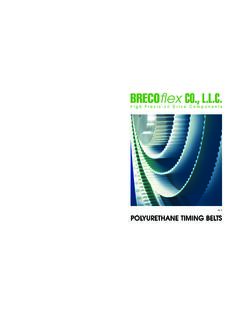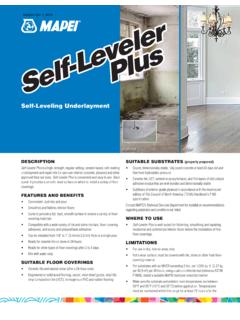Transcription of MATERIAL SAFETY DATA SHEET UltraSeal® PF-50 STRAW …
1 MSDS- PF-50 Page 1 of 4 MATERIAL SAFETY data SHEET Chemical Name: ultraseal PF-50 STRAW foam SECTION 01 CHEMICAL PRODUCT AND COMPANY IDENTIFICATION: Manufacturer: NUCO INC. 150 Curtis Drive Guelph, Ontario N1K 1N5 Tel: (519)-823-4994 Fax: (519)-8 23-1099 Infotrac 24 Hour Emergency Tel: (800)-535-5053 Date: May 1, 2011 Prepared by: Technical Services Department WHMIS Classification: A, B2, D2A Product Use: Polyurethane foam SECTION 02 COMPOSITION / INFORMATION ON INGREDIENTS: Ingredients_____ CAS %_____ LD50 (Oral-Rat) Urethane Pre-Polymer Blend LC50 (Inhalation-Rat) (Non-Hazardous Proprietary Blend) Not available Not available Not available 4,4 -Diphenylmethane Diisocyanate (MDI) 101-68-8 >5,000 mg/kg Not available Higher Oligomers of MDI (Polymeric MDI) 9016-87-9 Not available Not available Isobutane 74-28-5 Not available 658 mg/L (4h) Dimethyl Ether 115-10-6 Not available mg/L (4h) Propane 74-98-6 Not available Not available The ingredients listed above are controlled products as defined in CPR, am.
2 SOR/88-555 or 29 CFR SECTION 03 HAZARDS INDENTIFICATION: Eyes: May be irritating to eyes. foam contact can cause physical damage due to its adhesive character. ROUTES OF ENTRY INTO THE BODY (ACUTE EFFECTS): Skin: May cause localized irritation, reddening or swelling. Prolonged or repeated exposure may lead to sensitization and / or contact dermatitis. Inhalation: May irritate mucous membranes with tightness in chest, coughing or allergic asthma-like sensitivity. Prolonged overexposure can lead to respiratory symptoms like bronchitis and pulmonary edema. These effects are usually reversible. Overexposure to Liquefied Petroleum Gas (Hydrocarbon, HC) may cause lightheadedness, headaches or lethargy.
3 Individuals with cardiac arrhythmia may be at increased risk in severe exposure. Ingestion: May cause irritation of mucous membranes in the mouth and digestive tract. WHMIS HAZARD SYMBOL(S): DANGER: AEROSOL CAN CONTENTS UNDER PRESSURE AND EXTREMELY FLAMMABLE. DO NOT HEAT ABOVE 120 F (49 C), PUNCTURE OR INCINERATE. Eyes: Flush with copious quantities of lukewarm water. Seek medical attention immediately. SECTION 04 - FIRST AID MEASURES: Skin: Use a rag to remove excess foam from skin and remove contaminated clothing. Use of a mild solvent, such as acetone (nail polish remover) or MSDS- PF-50 Page 2 of 4 mineral spirits, may help in removing uncured foam residue from clothing or other surfaces (avoid eye / skin contact).
4 Cured foam may be physically removed by persistent washing with water and a non-abrasive soap. If irritation develops, use mild cream. If it persists, seek medical attention. Inhalation: Remove to fresh air if breathing difficulty is experienced. If necessary, provide oxygen or artificial respiration by trained personnel and obtain medical attention. Ingestion: Drink 1 or 2 glasses of water or milk. Consult physician. Do not give anything orally to an unconscious person. Flammable Conditions: VAPOR CAN IGNITE EXPLOSIVELY AND CAN CAUSE FLASH FIRE. Never use around sparks, flames or other sources of ignition. Cured polyurethane foam is organic and can burn in the presence of sufficient heat, oxygen and an ignition source.
5 SECTION 05 - FIRE FIGHTING MEASURES: Extinguishing Media: Carbon dioxide, dry chemical, Halon 1211, or chemical foam . Water can be used to cool fire exposed containers to prevent pressure build-up and possible explosion. Fire Fighting Measures: Self-contained breathing apparatus and protective clothing should be worn in fighting large fires involving chemicals. Determine the need to evacuate or isolate the area according to your local emergency plan. Flash Point: -156 F ( C) based on liquefied petroleum gas (Hydrocarbon, HC) Flammability Limits: Lower Explosion Limit - Not available Upper Explosion Limit Not available Autoignition Temperature: Not available Hazardous Decomposition Products: Carbon oxides, nitrogen oxides and traces of incompletely burned carbon products, hydrogen cyanide and hydrochloric acid.
6 Sensitivity - Impact: Contents could be sensitive to mechanical impact. Static: Contents could be sensitive to static discharge. Containment / Clean Up: Restrict access to the area of the spill. Provide ventilation, NIOSH / MSHA approved respirator and protective clothing. Uncured foam is very sticky and the bulk of the spilled MATERIAL should be scraped up and placed in container for disposal. Cleaning of the residual foam may require the use of rags and a solvent such as acetone (nail polish remover), mineral spirits, or paint thinners. Dispose of saturated absorbant or cleaning materials appropriately, since spontaneous heating may occur. Once the foam has cured, it can only be removed physically by scraping, buffing, etc.
7 Before disposing of containers, relieve the container of any remaining foam and pressure. Allow foam to fully cure before disposing (never discard in a liquid state). Local, state, provincial, federal laws and regulations may apply to releases and disposal of this MATERIAL , as well as those materials and items employed in the cleanup. SECTION 06 ACCIDENTAL RELEASE MEASURES: Handling and Storage: Store under dry conditions, between 60 F ( C) and 80 F ( C). Storage above 90 F ( C) will shorten the shelf life. Storage below 55 F ( C) may affect foam quality if the chemicals are not warmed prior to use. Protect unused product from FREEZING. Use only in well ventilated area. SECTION 07 HANDLING AND STORAGE: Component Exposure Limits: SECTION 08 EXPOSURE CONTROL / PERSONAL PROTECTION: 4,4 -Diphenyl Diisocyanate (MDI) (CAS# 101-68-8 ): Provide adequate ventilation to control exposures within the following exposure guidelines: ACGIH TLV: ppm (TWA) and OSHA: ppm (Ceiling).
8 Higher Oligomers of MDI (CAS# 9016-87-9) : Provide adequate ventilation to control exposures within the following exposure guidelines: Not established. Isobutane (CAS# 74-28-5), Dimethyl Ether (CAS# 115-10-6) and Propane (CAS# 74-98-6): Provide adequate ventilation to control exposures within the following exposure guidelines: ACGIH TLV: 1,000 ppm (TWA) and OSHA PEL: 1,000 ppm (TWA). MSDS- PF-50 Page 3 of 4 Respiratory: If vapor levels are expected to exceed exposure guidelines, wear a NIOSH / MSHA approved, positive pressure, supplied air respirator. Ventilation: In indoor applications, passive ventilation (opening of doors and windows) is recommended. Local exhaust as necessary to keep exposure levels within guidelines.
9 Personal Protective Equipment: SAFETY glasses with side-protection, impermeable gloves ( , neoprene, nitrile, silver shield (R)), coveralls or apron are important in preventing contamination of eyes, skin and clothing. Wash thoroughly after handling. Facilties storing or utilizing this product should be equipped with an eyewash facility and a SAFETY shower. Physical State: Viscous liquid which foams upon release from container SECTION 09 - PHYSICAL AND CHEMICAL PROPERTIES: Odor and Appearance: Slight hydrocarbon odor during curing stage, off-white to yellowish froth Odor Threshold: Not available Specific Gravity: Vapor Pressure: Contents under pressure have a vapor pressure greater than 50 psig (345 kPa).
10 After release from container, vapor pressure is very low (not determined). Vapor Density: Not available Evaporation Rate: Not available Boiling Point: Liquefied petroleum gas (Hydrocarbon, HC) components boil between -28 F to 11 F ( C to C). Other components boil at temperatures greater than 200 F ( C). Freezing Point: Not available pH: Not available Coeff. Oil/Water Distribution: Not available Chemical Stability: Stable under normal conditions of use. SECTION 10 STABILITY AND REACTIVITY: Incompatible Materials: Strong oxidizing agents, bases, amines, alcohols and small particle metal catalysts. Reactive Conditions: Heat, sparks and open flame. Hazardous Polymerization: Should not occur unless container is heated above 120 F (49 C).




